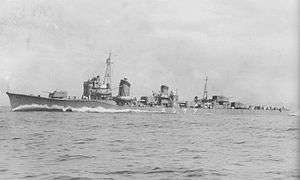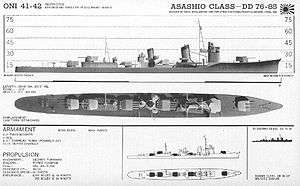Asashio-class destroyer
 Asashio underway in July 1937. | |
| Class overview | |
|---|---|
| Name: | Asashio class |
| Operators: |
|
| Preceded by: | Shiratsuyu class |
| Succeeded by: | Kagerō class |
| Built: | 1937–1939 |
| In commission: | 1939–1945 |
| Completed: | 10 |
| Lost: | 10 |
| General characteristics | |
| Type: | Destroyer |
| Displacement: | 2,370 long tons (2,408 t) |
| Length: |
|
| Beam: | 10.3 m (33 ft 10 in) |
| Draft: | 3.7 m (12 ft 2 in) |
| Propulsion: | 2-shaft geared turbine, 3 boilers, 50,000 shp (37,285 kW) |
| Speed: | 35 knots (40 mph; 65 km/h) |
| Range: | |
| Complement: | 200 |
| Armament: |
|

The Asashio-class destroyers (朝潮型駆逐艦 Asashio-gata kuchikukan) were a class of ten destroyers of the Imperial Japanese Navy in service before and during World War II.[1]
Background
The Imperial Japanese Navy was not entirely satisfied with the performance of the Shiratsuyu-class destroyer, particularly in terms of operational range and speed. However, given the limitations of the 1930 London Naval Treaty, it was considered impossible to modify these vessels any further to improve their specifications. This obstacle was removed after the Japanese government allowed the treaty to expire without renewal. The final four vessels of a projected 14 destroyers in the Shiratsuyu class were cancelled, and the larger new Asashio-class vessels were approved under the Maru-2 Supplementary Naval Expansion budget of 1934, with construction spanning 1935-1936. All ten vessels were lost in the Pacific War.[2]
Design
The Asashio class was the first Japanese destroyer class to exceed 2,000 tons displacement and the first to be equipped with sonar. Early critical issues with the Asashio class included the reliability of their new steam turbines engines, and issues with the design of their rudder, which were addressed by the start of the Pacific War.
In terms of armament, the Asashio class was similar to the previous Fubuki and hatsuharu classes, but with twin mount 5-inch guns like the fubukis instead of having a single mount like the hatsuharus. The guns were mounted in Type C gun turrets capable of 55-degree elevation. Also, the position of the "X" turret at the shelter deck level forward of the quarterdeck "Y" turret, gave the Asashio class a different silhouette than the Shiratsuyu class, where both turrets were at quarterdeck level. The torpedo armament of eight 24-inch torpedo in two quadruple launchers was retained, with the torpedo reloads stored in a deckhouse on the centerline. This design became the basic plan for all future destroyers in the Japanese navy.
The Asashio-class vessels had three boilers running two geared turbine shafts with an output of 50,000 hp (37,000 kW) at the screws, giving it a top speed of 35 knots (65 km/h) and a range of 5,700 nautical miles (10,600 km) at 15 knots (28 km/h) or 960 nautical miles (1,780 km) at 34 knots (63 km/h).[3]
In the middle of the Pacific War (1943–44), on surviving vessels the "X" turret was removed and replaced by triple Type 96 25 mm anti-aircraft guns, increasing the total number to 15. After June 1944, even more anti-aircraft guns were added, raising the total to between 15 and 28 Type 96 guns and four Type 93 13 mm guns. Four depth charge throwers and 36 depth charges were also fitted at between 1943 and 1944. The last four surviving vessels were also equipped with Type 13 and Type 22 radar.
Operational history
During the war the Asashio class was used extensively in the protection of the Combined Fleet. Arare was attacked and sunk off Kiska Island during the Aleutian Islands Campaign by USS Growler on 5 July 1942. Kasumi was also heavily damaged along with one other destroyer. Asashio and Arashio escorted the 7th Cruiser Division at the Battle of Midway, where both were damaged by air attack. Although repaired and returned to service, both were sunk in 1943 when a large Japanese transport force was destroyed by American planes in the Battle of the Bismarck Sea. Michishio, Asagumo, and Yamagumo were lost in 1944 in the Battle of Leyte Gulf. Kasumi, last of the class to be laid down, served as escort on the attack on Pearl Harbor and joined the battleship Yamato during Operation Ten-Go against the American fleet at Okinawa. None of the Asashio-class ships survived the Pacific War.[4]
List of ships
| Ship | Shipyard | Laid down | Launched | Completed | Fate | |
|---|---|---|---|---|---|---|
| 朝潮 | Asashio | Sasebo Naval Arsenal | 7 September 1935 | 16 December 1936 | 31 August 1937 | Air Strike,4 March 1943 |
| 大潮 | Ōshio | Maizuru Naval Arsenal | 5 August 1936 | 19 April 1937 | 31 October 1937 | Torpedoed, 20 February 1943 |
| 満潮 | Michishio | Fujinagata Shipyards | 5 November 1935 | 15 March 1937 | 31 October 1937 | Surface action, 25 October 1944 |
| 荒潮 | Arashio | Kawasaki-Kobe | 1 October 1935 | 26 May 1937 | 30 December 1937 | air attack, 4 March 1943 |
| 朝雲 | Asagumo | Kawasaki-Kobe | 23 December 1936 | 5 November 1937 | 31 March 1938 | surface action, 25 October 1944 |
| 山雲 | Yamagumo | Fujinagata Shipyards | 4 November 1936 | 24 July 1937 | 15 January 1938 | surface action, 25 October 1944 |
| 夏雲 | Natsugumo | Sasebo Naval Arsenal | 1 July 1936 | 26 May 1937 | 10 February 1938 | air attack, 15 October 1942 |
| 峯雲 | Minegumo | Fujinagata Shipyards | 22 March 1937 | 4 November 1937 | 30 April 1938 | surface action, 5 March 1943 |
| 霰 | Arare | Maizuru Naval Arsenal | 5 March 1937 | 16 November 1937 | 15 April 1939 | torpedoed, 5 July 1942 |
| 霞 | Kasumi | Uraga Dock Company | 1 December 1936 | 18 November 1937 | 24 June 1939 | air attack, 7 April 1945 |
See also
Notes
- ↑ Jentsura, Warships of the Imperial Japanese Navy, 1869-1945
- ↑ Globalsecurity.org, IJN Shiratsuyu class destroyers
- ↑ Roger Chesneau, ed. (1980). Conway's All the World's Fighting Ships 1922-1946. Grenwitch: Conway Maritime Press. ISBN 0-85177-146-7.
- ↑ Brown, David (1990). Warship Losses of World War Two. Naval Institute Press. ISBN 1-55750-914-X.
- ↑ Nishida, Hiroshi. "Materials of IJN: Shiratsuyu class destroyer". Imperial Japanese Navy.
Books
- Evans, David (1979). Kaigun: Strategy, Tactics, and Technology in the Imperial Japanese Navy, 1887-1941. US Naval Institute Press. ISBN 0-87021-192-7.
- Brown, David (1990). Warship Losses of World War Two. Naval Institute Press. ISBN 1-55750-914-X.
- Roger Chesneau, ed. (1980). Conway's All the World's Fighting Ships 1922-1946. Grenwitch: Conway Maritime Press. ISBN 0-85177-146-7.
- Howarth, Stephen (1983). The Fighting Ships of the Rising Sun: The Drama of the Imperial Japanese Navy, 1895–1945. Atheneum. ISBN 0-689-11402-8.
- Jentsura, Hansgeorg (1976). Warships of the Imperial Japanese Navy, 1869–1945. US Naval Institute Press. ISBN 0-87021-893-X.
- Watts, A. J. Japanese Warships of World War II, Ian Allen, London, 1967.
- Whitley, M. J. (1988). Destroyers of World War 2. Cassell Publishing. ISBN 1-85409-521-8.
External links
| Wikimedia Commons has media related to Asashio class destroyers. |
- Nishida, Hiroshi. "Materials of IJN: Asashio class destroyer". Imperial Japanese Navy.
- Globalsecurity.org. "IJN Asashio class destroyers".